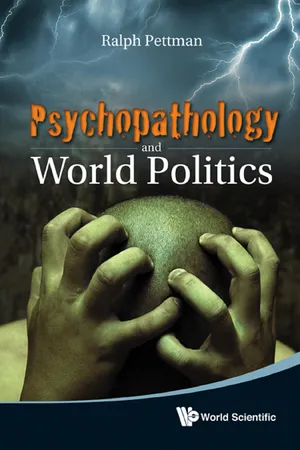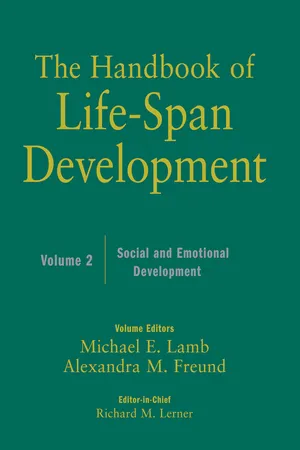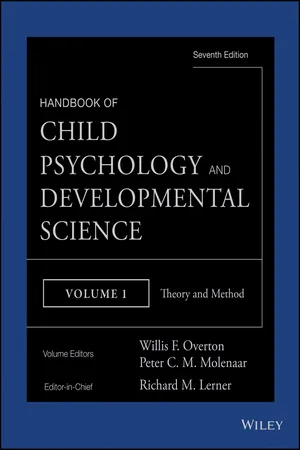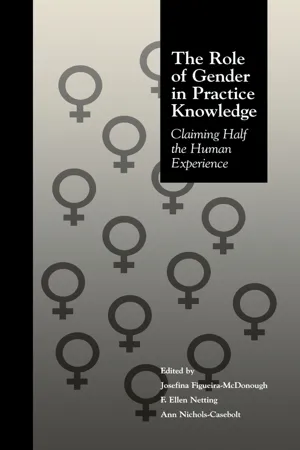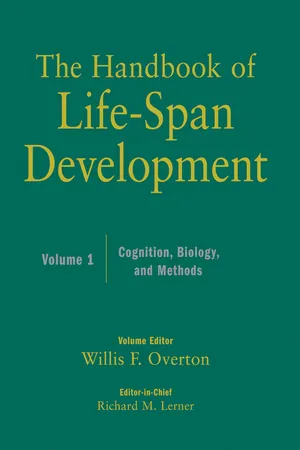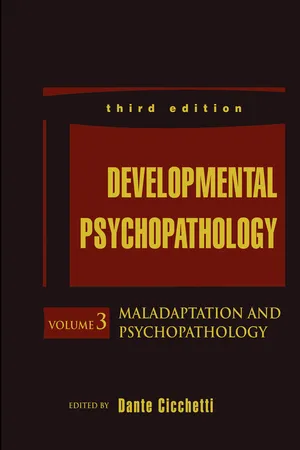Psychology
Psychopathology
Psychopathology refers to the study of mental disorders and abnormal behavior. It involves understanding the causes, symptoms, and treatment of psychological disorders such as depression, anxiety, schizophrenia, and personality disorders. Psychopathology aims to identify and classify different mental health conditions, as well as to develop effective interventions to alleviate psychological distress and improve overall well-being.
Written by Perlego with AI-assistance
Related key terms
8 Key excerpts on "Psychopathology"
- eBook - ePub
- Ralph Pettman(Author)
- 2011(Publication Date)
- WSPC(Publisher)
1Psychopathology refers to forms of behavior that seem so dysfunctional that they denote ill-health. It refers to those “morbid” mental phenomena that some people must deal with some of the time and other people must endure all of the time. It is, in short, the “systematic study of abnormal experience, cognition and behavior — the study of the products of the disordered mind” (Oyebode, 2008, p. 3).As such, it is one of those concepts that is easier to recognize than it is to define (Davis, 1984, p. 1; Page, 1975, pp. 3, 49). The problem is that Psychopathology is concerned with “every psychic reality which we can render intelligible…”. It is concerned, that is, with the way the self endlessly attempts to comprehend the world. This makes it necessary to know what people experience in general before it is possible to say what might be wrong with them in particular. It makes it necessary to know the full nature of their psychic reality. This reality can only be known by objectifying the human psyche and then compensating for the limits and distortions of detachment by the use of empathy and understanding (Oyebode, 2008, p. 3). Only after such a comprehensive appraisal is it possible to determine what the conscious as opposed to the unconscious means and what the inner as opposed to the outer world entails. Only then can it be said what might mentally be the matter (Jaspers, 1972 [1913]).It should also be noted that Psychopathology is used to refer to various techniques that are currently believed to provide people who behave in a mentally unwell way with some kind of help. It has a prescriptive as well as a descriptive and an explanatory dimension.In other words, Psychopathology is supposed to provide a rational basis for identifying those who suffer mentally as opposed to those who suffer physically. It is also supposed to allow for the identification of those who suffer psychosomatically, that is, those who suffer physically because of their state of mind (for instance, those who develop an ulcer because they worry too much), as well as those who suffer psychologically because of the state of their brain or some other part of their body (for instance, those who lose their memory because of Alzheimer’s disease). Psychopathology is supposed in all such cases to provide a rational basis for restorative or at very least palliative care. - eBook - ePub
- Alessandra Lemma(Author)
- 1996(Publication Date)
- SAGE Publications Ltd(Publisher)
1 What is Psychopathology? Any attempt to define what Psychopathology is presupposes that we really know what normality is. In view of this, any consideration of Psychopathology requires an examination of the notions of mental health and illness and their inherent assumptions and biases. This will be the aim of the first part of this chapter. It will be followed by an exploration of some of the functions served by the notion of mental illness. Throughout history, people’s understanding of Psychopathology has constantly shifted; different cultures and historical periods have labelled ‘mad’ those whom other times and societies have regarded as ‘sane’. Indeed, it has been argued that madness is nothing but a label pinned by the respectable on those they cannot tolerate or that society is in actuality so demanding or alienating that it drives the most vulnerable souls to distraction. Psychopathology or madness can even be seen as being merely sophisticated euphemisms for human anguish. Since the ancient Greeks, psychopathological manifestations have been treated by a variety of social organisations including the Church, the law and medicine. In modern Western society medicine is the main source of identification and care for Psychopathology. In spite of the attempts of the medical profession to use scientifically loaded terms reified within systems of psychiatric classification, the question of Psychopathology has nevertheless remained shrouded in mystery. The term ‘Psychopathology’ generally refers to patterns of maladaptive behaviour and states of distress which interfere with some aspect of adaptation. Implicit in the American Psychiatric Association’s (1994) Diagnostic and Statistical Manual (DSM-IV) definition of ‘mental disorder’ is that the mental condition causes significant distress or disability (impairment in one or more important areas of functioning) and that it is not merely an expected and culturally sanctioned response to a particular event - eBook - ePub
The Handbook of Life-Span Development, Volume 2
Social and Emotional Development
- (Author)
- 2010(Publication Date)
- Wiley(Publisher)
In this chapter, a developmental Psychopathology approach to high-risk conditions and psychiatric disorders is presented. Following a brief account of its historical underpinnings, the interdisciplinary field of developmental Psychopathology is described. In the next section, the definitional parameters and principles of developmental Psychopathology are discussed, and illustrations of these tenets are provided through examples from a number of high-risk conditions and psychiatric disorders across the life span. In the penultimate section, research on the genetic, neurobiological, and psychological correlates and sequelae of child maltreatment is used as an exemplar of a multilevel developmental Psychopathology approach. Finally, autism, depression, substance abuse, and schizophrenia are presented as illustrations of a developmental perspective on mental disorder. For a more elaborate, in-depth treatment of a developmental Psychopathology approach to high-risk conditions and mental disorders, the reader is referred to Cicchetti and Cohen (1995a, 1995b, 2006a, 2006b, 2006c).HISTORICAL UNDERPINNINGS OF DEVELOPMENTAL Psychopathology
Despite its relatively recent crystallization as a coherent framework for investigating the relation between normality and Psychopathology, the field of developmental Psychopathology owes its emergence and coalescence to a number of historically based endeavors in a variety of disciplines, including embryology; epidemiology; genetics; the neurosciences; philosophy; psychoanalysis; clinical, developmental, and experimental psychology; and sociology (Cicchetti, 1990; Costello & Angold, 2006; Kaplan, 1967; Masten, 2006). Many of the great theorists in these influential disciplines have reasoned that we can learn more about the normal functioning of an organism by studying its pathology and, likewise, more about its pathology by investigating its normal condition (Cicchetti, 1984). A number of these integrative thinkers conceived of Psychopathology as a magnifying mirror in which normal biological and psychological processes could better be observed. Because these systematizers conceptualized Psychopathology as a distortion or exaggeration of the normal condition, the study of pathological phenomena was thought to throw into sharper relief one’s understanding of normal processes. - (Author)
- 2015(Publication Date)
- Wiley(Publisher)
Moreover, DP by design is articulated as a “work in progress,” still being shaped and developed. Toward achieving the best theory and treatment in the long run, DP is intentionally open, flexible, and responsive to new research, concepts, and methods, with self-consciously “permeable” boundaries with regard to multiple other areas that may potentially contribute to understanding of the development of Psychopathology (Cummings et al., 2000). That is, “developmental Psychopathology is an evolving scientific discipline whose predominant focus is elucidating the interplay among the biological, psychological, and social-contextual aspect of normal development across the lifespan” (Cicchetti, 2006, p. 1).This definition reflects the assumption that the optimal study of the processes underlying human development requires that multiple domains, factors, and variables be studied and evaluated, and that the best conceptual and treatment models will ultimately emerge from cross-fertilization and integration across multiple and diverse disciplines. A guiding assumption of DP is that the adequate study of the full range of processes contributing to human development requires a collaborative endeavor that spans disciplinary boundaries. Toward increasing the articulation of developmental processes underlying Psychopathology across multiple domains, DP encourages research and theory that crosses traditional boundaries of psychological, medical, and biological sciences (Cummings et al., 2000).The historical origins of the field are derived from the contributions of multiple disciplines, including embryology, philosophy, psychiatry, biology, experimental, clinical and developmental psychology; matters which have been treated in detail elsewhere (e.g., Cicchetti, 1990, 2006). Thus, the area has been defined in the context of a mix of interrelations with other perspectives on the development of Psychopathology and continues to advance in the context of this multiplicity of diverse influences.Toward further defining the field, the differences and overlapping themes with several closely related areas merit consideration. An important caveat is that these are broad distinctions and over the years some of the most closely related areas have become overlapping to an increasing degree.- eBook - ePub
The Role of Gender in Practice Knowledge
Claiming Half the Human Experience
- Josefina Figueira McDonough, F. Ellen Netting, Ann Nichols Casebolt(Authors)
- 2018(Publication Date)
- Routledge(Publisher)
Most teachers of human behavior courses recognize variations in human behavior and that the etiology and mutability of these variations can be studied. But, the enterprise of differentiating particular behavioral patterns as abnormal or pathological is not the traditional province of social work. Social work teaches respect for human diversity. The notion of person/environment fit reminds us that most human variations can be a strength as well as a weakness depending upon the context of the behavior. Social work eschews the process of negative trait identification, in the belief that helping people identify and maximize their strengths will result in more satisfaction and less distress for all individuals involved (Turner, 1984). The thesis behind the DSM-IV is in fundamental conflict with the strengths' orientation of social work. For this reason, Psychopathology has taken on a different meaning in social work from that of psychiatry and other mental health professions.Psychopathology in social work is not the concept to which medicine and conservative politicians have reduced it. In social work, we are committed to a sense of Psychopathology that "harkens back to the original Greek." According to this etymology, the word "Psychopathology" refers to the speech or logos of the psyche—that is, all the psyche's ways of hiding, manifesting, expressing, communicating, sharing, and in brief, living out its experience of worldly suffering (pathein) (Levin, 1987, p. 2). This sense of suffering is rooted in the psyche's historical situation. Within these changing historical contexts, social work educators must find places in the curriculum to evaluate the foundation assumptions underlying extant concepts of pathology and other forms of victimization (Ashford, 1994).So how can a teacher of social work approach the task of integrating gender content into a subject matter that is in conflict with many fundamental social work principles? The task requires a commitment from educators to clarifying how diagnostic and other classification systems are influenced by social processes. Just as history books are written by the victors, the definition of disorder will be a social construction that is significantly influenced by male hegemony. Males and others with power will decide what constitutes a problem. For feminists, of course, there is instant recognition that as a disenfranchised group, women will be infrequently consulted in the process of deciding what is pathological. This responsibility of defining pathology is still left up to "the university educated, economically privileged, predominantly white men who have produced our systems of science and technology" (Hubbard, 1989, p. 119). - eBook - ePub
The Handbook of Life-Span Development, Volume 1
Cognition, Biology, and Methods
- Richard M. Lerner, Willis F. Overton(Authors)
- 2010(Publication Date)
- Wiley(Publisher)
Immediately after the child participated in one of these environments, he was readministered the Miniature Situations Test II and the Structured Fantasy Test. Results show that action-oriented boys who experienced an action environment displayed a progressive reorganization of that mode (e.g., they turned a screw into wood first, then hammered a nail, and then smashed a light bulb) and a regressive reorganization of the nonpreferred mode (e.g., a dog’s paw was bitten by another dog). On the other hand, fantasy-oriented boys who participated in the fantasy environment expressed more direct-immediate actions (e.g., they smashed the light bulb first) and more indirect-delayed fantasies (e.g., they imagined the dog stepped on a stone). The boys who experienced an environment opposite to their preferred mode of expression displayed confusion and conflict when responding to the assessment procedures. These results suggest that when an environment provides opportunities to engage ingredients converging with one’s preferred instrumental-expressive mode, the dialectical relation between action and fantasy facilitates a transfer from the preferred mode as the instrument of expression to the other. And when the environment emphasizes engaging ingredients that oppose one’s preferred instrumental-expressive mode, the inner self experiences cognitive-emotional-behavioral confusion that, if it continues, could result in the development of psychopathological functioning. These results also raise questions and should stimulate studies of the relations between environments and cognitive, behavioral, and emotional elements. For example, given the growing use by youths of computer games, how does this environment affect the processes of cognitive-emotional regulators and instrumental-expressive behaviors in school? As another example, how would adults of different ages who watch two or three movies a week differ from those who do not?CONCLUSIONS
We noted at the start that the discipline of developmental Psychopathology emerged in the early 1980s in a conceptual atmosphere dominated by the viewpoint of nosology, which had gained momentum when the American Psychiatric Association published the first manual of mental disorders in 1952. We also noted that this viewpoint continued to dominate, stimulated by the influence of four editions released in the following years, conceptualizing Psychopathology in terms of more than 200 segregated diagnostic categories, each defined by a fixed set of symptoms. We considered how this conceptualization continues to influence research and stimulates the use of questionnaires and self-report as methods to assess cognitive and personality traits. We also discussed that nosology has been challenged over the years, beginning with an NIMH-sponsored conference held after the first manual was released. Of particular relevance to my presentation, recall that after the second edition of this manual was released, Piaget (1975) advocated that psychiatry places too much emphasis on the principle of syndromes, and that psychological difficulties should not be conceptualized as fixed, behavioral traits because a person may function adequately at one moment and not at another. Piaget’s position forecast the criticism, which we summarized, that has been levied against the DSM approach, illustrated by Kutchins and Kirk (1997), who argue that nosology defines ordinary behavior as pathological, “making all of us crazy.” Another investigator (Watson, 2005), anticipating the next edition (DSM-V) scheduled for publication in 2012, proposes that it may help if diagnostic categories are organized to form a hierarchy. Criticisms continue to be levied, however, at the manual under preparation; for example, the degree to which the pharmaceutical industry influences DSM revisions because specific medications are designated for particular diagnostic categories (Bradshaw, 2008), and the secrecy surrounding the preparation of DSM-V (Bradshaw, 2009). - eBook - ePub
- Theodore P. Beauchaine, Stephen P. Hinshaw(Authors)
- 2016(Publication Date)
- Wiley(Publisher)
As a result, strict adherence to DSM criterion sets without consideration of race, ethnicity, and class can lead to both false positive and false negative conclusions regarding the presence versus absence of Psychopathology. One objective of the developmental Psychopathology approach is to construct a discipline that acknowledges the role of context in shaping behavior, and that does not assume—even implicitly—that group differences in behavior between members of the dominant social class and other cultural subgroups always imply deficits in functioning among the latter (e.g., Garcia-Coll, Akerman, & Cicchetti, 2000; Cicchetti & Toth, 2009; see also Chapter 1 [Hinshaw]). EMPIRICALLY DERIVED CLASSIFICATION SYSTEMS Early on, the DSM was, and in many ways remains, a top-down, deductive approach to classifying Psychopathology. Opinions of experts are still weighed heavily in the revision process, and empirical findings are sometimes eschewed, despite explicit calls for, both within and outside DSM workgroups, a research-based taxonomy of mental illness (see above). In stark contrast to this approach, developmental psychopathologists have a long history of constructing and using, in both research and clinical settings, bottom-up, inductive systems of classification and assessment that derive almost fully from empirical interrelations among symptoms of Psychopathology. The earliest and most renowned of these is the parent-report Child Behavior Checklist (CBCL; Achenbach & Edelbrock, 1983), which was later expanded to include both teacher (Teacher Report Form [TRF]; Achenbach & Edelbrock, 1986) and self-report versions (Youth Self-Report [YSR]; Achenbach & Edelbrock, 1987). Collectively, these instruments, along with more newly developed adult versions, comprise the Achenbach System of Empirically Based Assessment (ASEBA; Achenbach, 2009). The CBCL and its successors were derived from factor analyses of large sets of symptoms of Psychopathology - Dante Cicchetti(Author)
- 2016(Publication Date)
- Wiley(Publisher)
One can easily imagine other major critical periods in later life that could give rise to PD onset. For example, in late life, a person's health often begins to change. A younger person with a certain amount of paranoia might not show functional impairment associated with paranoid PD because he has a healthy body and reasons that he can engage in certain degrees of self-protection in public if needed, as described previously in this chapter. That same individual, now old, frail, and vulnerable, might find himself trapped in his home, still paranoid about others but now afraid to leave the house. In this example, the PD might interact with changes in health to cross some threshold of dysfunction for the first time in later life.The bottom line is that later life is a dynamic time with lots of changes that can give rise to previously unseen PD pathology. The extent to which these late life changes reveal PD pathology is not well understood because we do not currently have good data upon which to base such observations. Clearly, though, examining PD pathology in later life would allow us to understand the stability and changeability of PD pathology across the life span and help us to understand how context affects the presentation of PD pathology even into later life.Conclusions and Future Directions
The current chapter had multiple goals, with one overarching theme: a desire to understand PD development across the life span within a developmental Psychopathology framework. PDs lend themselves especially well to a developmental Psychopathology perspective, as the rich and growing literature on normal-range personality measurement and development has much to offer a better understanding of measurement and development of personality pathology. We reviewed literature on the longitudinal course for both normal and pathological personality, which show numerous similarities to one another. Importantly, such studies point to converging evidence for both stability and change in the development of normal and abnormal personality across the life span. Such evidence supports the need to examine the emergence and impact of PDs in early life, while also emphasizing their potential for change and the need to better understand the moderating roles of context and developmental stage.Although we largely confined ourselves to language codified in the DSM-IV and DSM-5
Learn about this page
Index pages curate the most relevant extracts from our library of academic textbooks. They’ve been created using an in-house natural language model (NLM), each adding context and meaning to key research topics.
